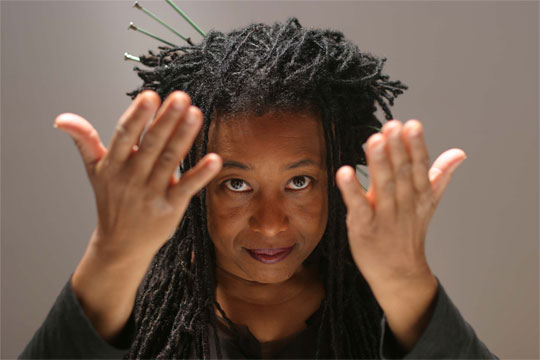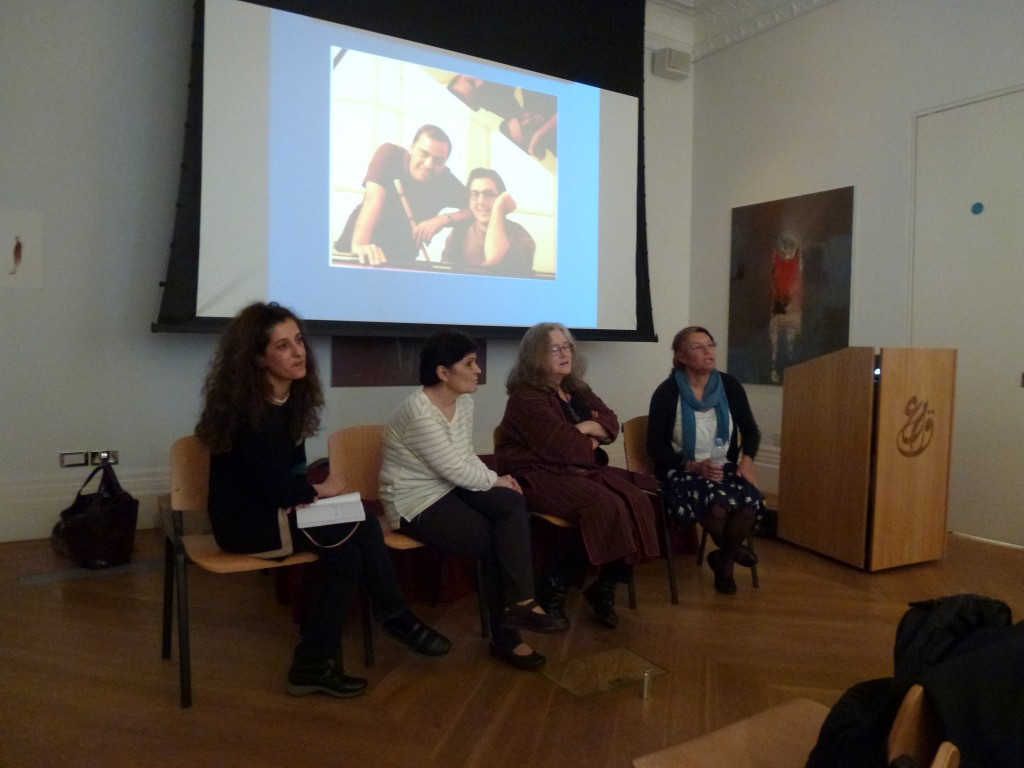
Pamela Z (photo credit: Donald Swearingen)
Next week City University’s Concert Series presents ‘Electric City’, a concert of electronic and audiovisual works. The programme includes works by Lauren Sarah Hayes, Joseph Hyde, Orestis Karamanlis and we’re delighted to welcome Pamela Z from the USA, who will be performing a number of her compositions for voice and live electronics. We spent some time speaking to Pamela about her work.
Your voice is central to your solo performances with live electronics. Could you talk a little about your vocal style and how this has evolved since you first trained as a classical singer?
I’ve been a musician all my life, so I think that my vocal style has been developing for a very long time. I wrote songs and was constantly singing during my childhood and youth. I got my first classical voice training in high school, where I had a very good concert choir teacher who took a lot of care and gave a lot of private attention to the students she felt were gifted, so I actually sang opera arias in High School. And I was a voice major in college, and continued to study with a bel canto teacher off and on long after I was out of school. But, through all of that training, I was always writing and singing my own songs as well, which were, for many years, focused on a kind of folk or rock singing style. I used to find it difficult to figure out what to do with these separate singing styles and reconcile them in any cohesive way.
I feel that I actually “found my voice” as an artist when I started working with electronic processing and composing and performing works of a more experimental nature. I realized that it was possible to incorporate “bel canto” style in my work, along with a wide array of experimental vocal techniques and spoken text. And that it was possible (and even desirable) to combine these styles – even within a single work or a single phrase. So I suppose I would characterize the evolution as more of an expansion of the possibilities of timbre and techniques, and a removal of the solid lines that used to separate the different approaches to singing.
Why do you work with live electronics? And how does your live electronics setup change from one work to another?
I actually consider my instrument to be the combination of my voice and the electronics. I work with live electronics because I like the way I can expand my palette of possible colours and textures even beyond the already wide ranging possibilities inherent in the most flexible instrument that is the human voice. My vocal sound is mediated through the electronics in ways that usually result in recognisably vocal sound, albeit layered or granulated, pitch shifted or, at times, distorted. And, I enjoy the possibilities that come from being able to add sampled found sounds to the mix and control and manipulate those sounds via various gesture control devices. I like to think that the interplay between the electronics and my voice is very organic.
My setup involves a main MAX patch that I consider to be the heart of my processing instrument, and a few other auxiliary patches that work together with that patch. I constructed and developed that patch over the years with a lot of help from some of my über Max-geek senseis. The idea, originally, was to replace a hardware setup that I started putting together back when I first started processing my voice in the early 1980s. It involved a lot of delay lines and multi-effects units and a sampler, so I strived to create that same set-up in MAX MSP. So, a lot of artists I knew who were using MAX tended to build a new patch every time they composed a new piece. But I tend to see my patch as the instrument I use in all my pieces. I just change parameters (like delay lengths, panning, granular settings etc) and create presets within the patch to make it appropriate for each work I perform. I start a concert with this integrated set of MAX patches open, and I just switch my presets for each piece as I perform my concert.
The performance on Tuesday will include video. What is the relationship between the aural and the visual in your solo performances?
I actually work quite regularly combining image and sound these days. Sometimes I see the visual component as an extension of the sonic component – just expanding the work to include the visual realm. Other times the visual just acts as a kind of setting for the work – like a lighting design that enhances the completeness of the experience. There are some works I do where the video is interactive – either responding to the sound of my voice or to gestures I’m doing that are also triggering or manipulating sound. I think I like to see different media as intertwined and, again, I like erasing or at least blurring the lines that sometimes segregate the different disciplines and practices. I believe that live performance does that already, even when there is no video. I think of my physical presence – my gestural movement and facial expressions etc – as integral parts of the compositions.
What other projects are you working on at the moment?
I have many irons in the fire as they say. A big project I’m currently working on is a multi-media chamber work called Carbon Song Cycle. It’s a collaboration with a video artist, Christina McPhee. I composed the music for voice & electronics, viola, cello, bassoon, and percussion, and Christina made immersive multi-channel video projections. We premiered this work at the Berkeley Art Museum in April, and we’re about to give the New York premiere at Roulette in Brooklyn this month (November 20th.) We’ll perform it in San Francisco in February of 2014, and we’re actively seeking bookings for it elsewhere. It’s the kind of work that might be fun to take to Universities and work with musicians from the college of music student body to perform the work.
Right now, I’m also in the midst of working with a composer/inventor collaborator of mine, Donald Swearingen, developing a new x-y-z gesture controller that I hope will inspire a great deal of new interactive works.
I’m also planning some new solo projects including a performance work about memory. And I’ve been doing a lot of media installations as well. I currently have an exhibition of my installation work Baggage Allowance running at the Fine Art Gallery at Bowling Green State University in Ohio. (And my browser-based version of that work is always available for exploring online at baggageallowance.tv)
And how does it feel to be woman working in the male-dominated field of performance and composition with technology?
I will say that I tend not to really think about it so much except in those cases where people say or do things that are blatant reminders of the issue. Otherwise, I tend not to be so very focused on the issue of gender when thinking about my work.
But it’s interesting how that has been constantly shifting and changing over the years. Things are much improved in that regard since the time I first started working in this field. It still has a long way to go, but things are noticeably different today. It used to be that, if I was selected to appear on a compilation of electroacoustic music, I’d be the only woman on the disc (unless it was one of those “a collection of women composers” type discs.) That isn’t so much the case anymore. More women are getting the notice and respect they deserve in the field. So that’s good news. But there’s always room for improvement.
One other comment I’ll offer is this: the fields of electronic music and music & technology are clearly still male dominated, but there is one area that woman have always had the edge on. That is the practice of combining voice and electronics. There always have been more women than men who work with live voice combined with electronics. It might be due to the fact that women lead the field of experimental vocal work in general, but I’ve always found it to be true. One can easily rattle off a list of women who compose and perform works for voice and electronics – Diamanda Galas, Laurie Anderson, Amy X Neuburg, Joan LaBarbara, Maja Ratkje, AGF, Pamela Z etc. But try to think of more than one or two men known for doing that. It’s just something interesting to think about.
—
More information on Pamela Z’s work can be found on her website.
Pamela Z will be performing on Tuesday 12th November at 7pm in the Performance Space, College Building.
Admission is free. To book a place go to: http://www.city.ac.uk/events/2013/november/electric-city-with-guest-performers-lauren-sarah-hayes-and-pamela-z
Or follow us on facebook: http://facebook.com/CityUniConcerts




